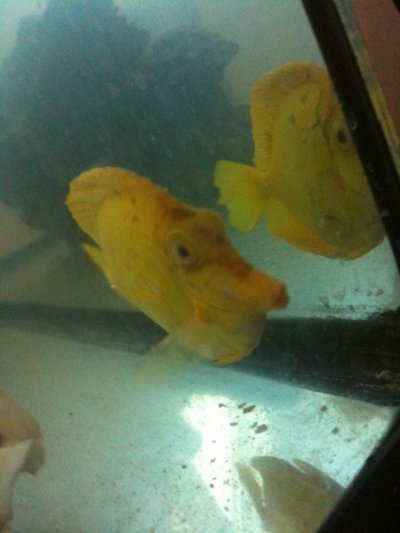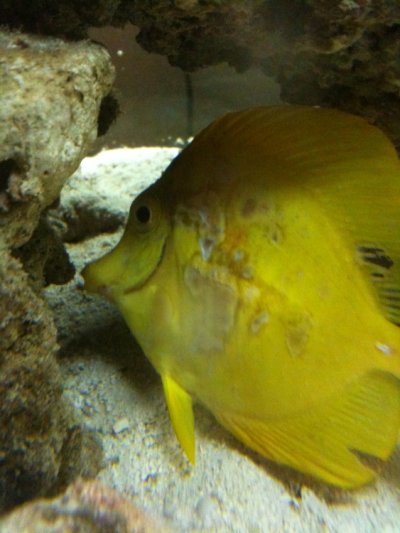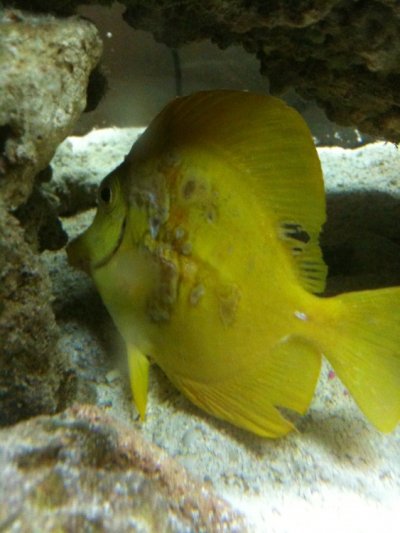Okay, after adding a blue hippo 2 weeks ago, I believe I encountered ich on him. I tried treating with water changes and garlic but it got worst and spread to my clown and yellow.
I set up a 25g quarantine tank and after much research decided I would treat in there with a product I had called nox-ich.
Within one hour the blue hippo that took me a half hour to catch was dead Within a few more hours I started to notice brown marks on my yellow tang (see first pic).
Within a few more hours I started to notice brown marks on my yellow tang (see first pic).
I tested the water and ammonia was sky high 1.0. I did big water change, tested again, still high. left it for a bit, now my clown was showing signs of its stress. Yellow tang fins eating away. I had to make a choice, keep them in the death trap of ammonia or put them back in my cycled tank with ich. Two more water changes and the ammonia would not go down. I am figuring the scars are ammonia burn.
After an emergency visit to my LFS, we decided that instead of using copper in the quarantine tank and risking ammonia poisoning further I would buy a product called kick-ich. It is apparently safe for reef, live rock. I mix of review about it on google search some say works other say not. What are my options at this point??
So I got home switched them back to the display tank and they live over night. Yellow tang looks like he's pealing skin like a sun burn and grey eyes. Clown swimming at the top of tank.
I leave for work for the day and now come home to a dead clown and tangs eyes look a little better but his fins are worse and the pealing of his skin is worse (see pic 2 & 3).
What is the cause of this?? Ammonia burn?? Flux?? I need help!! I don't know what to do and obviously don't want to loose anymore fish, this is a hard lesson as it is.
I set up a 25g quarantine tank and after much research decided I would treat in there with a product I had called nox-ich.
Within one hour the blue hippo that took me a half hour to catch was dead
I tested the water and ammonia was sky high 1.0. I did big water change, tested again, still high. left it for a bit, now my clown was showing signs of its stress. Yellow tang fins eating away. I had to make a choice, keep them in the death trap of ammonia or put them back in my cycled tank with ich. Two more water changes and the ammonia would not go down. I am figuring the scars are ammonia burn.
After an emergency visit to my LFS, we decided that instead of using copper in the quarantine tank and risking ammonia poisoning further I would buy a product called kick-ich. It is apparently safe for reef, live rock. I mix of review about it on google search some say works other say not. What are my options at this point??
So I got home switched them back to the display tank and they live over night. Yellow tang looks like he's pealing skin like a sun burn and grey eyes. Clown swimming at the top of tank.
I leave for work for the day and now come home to a dead clown and tangs eyes look a little better but his fins are worse and the pealing of his skin is worse (see pic 2 & 3).
What is the cause of this?? Ammonia burn?? Flux?? I need help!! I don't know what to do and obviously don't want to loose anymore fish, this is a hard lesson as it is.



